
A 1.8-54 MHz 1KW RF Deck incorporating all updates applied to the original through June 2017

This RF deck was developed on .078 thick FR4, and incorporates all the changes made to the original one done on TC350 through May 2017. The performance is the same (same output power) with slightly lower gain, which results from the use of a more effective gain stabilizing circuit. These are the advantages to this design over the original:
The need for board spacers has been eliminated
A simpler heat spreader is used, cut from .375" flat copper plate
The heat spreader no longer requires a slot (for mounting the LDMOS) to be machined into the copper
heat spreader size is now the same as the board footprint (4 x 6.5"), is .375 thick, and has a bit more mass ( it weighs more than 3 pounds)
The heat spreader does not require tapped mounting holes; instead, it uses 12 pass-through holes designed to make the rf deck easier to construct and mount to a heat sink. The Aluminum heat sink is now the only piece requiring tapped mounting holes.
Overall height has been reduced
The cost has been reduced
Here's the schematic for this RF deck:
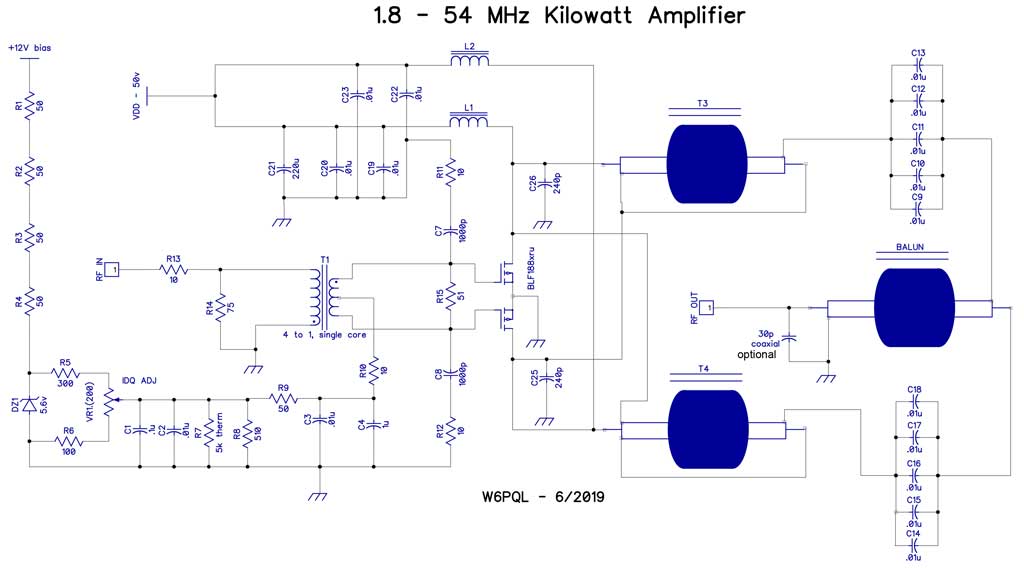
If you are building this RF deck from a kit I supplied, here are the assembly instructions:

Begin with the output board, and install all of the capacitors to their
positions shown here
 Cut
two pieces of RG316 coax to a length of 14.5 inches (37cm). Pair them as shown,
and wind them through one of the large ferrite cores, passing the paired coax 4
times through the center of the core from left to right.
Cut
two pieces of RG316 coax to a length of 14.5 inches (37cm). Pair them as shown,
and wind them through one of the large ferrite cores, passing the paired coax 4
times through the center of the core from left to right.
By using two pieces of identical 50 ohm coax like this in parallel, we are
duplicating the characteristics of 25 ohm coax. At 50 MHz and below, this RG316
Teflon coax can handle more than 3 times the power it will actually need to
handle in this circuit.

Remove 1/2" insulation from each of the 4 ends. Flare the shields back,
leaving about 5mm of the shields unflared; tin the unflared shields at the
location of the red arrow.
 Trim
the flared parts of the shields away with a pair of diagonal cutters; this is
best done by holding the cutting blades parallel to the coax as the flared
portions are trimmed away.
Trim
the flared parts of the shields away with a pair of diagonal cutters; this is
best done by holding the cutting blades parallel to the coax as the flared
portions are trimmed away.
Taking care not to cut into the center conductors (which weakens them), remove all but 3mm of insulation from the ends as shown in the photo, and tin the center conductors.
Prepare the second transformer in the same way as the first.
 Install
the first transformer by soldering both cables at one end to the traces as
shown, center conductors to the bottom trace, shields to the top, making certain
the insulated part of the center conductors is all that bridges the gap.
Install
the first transformer by soldering both cables at one end to the traces as
shown, center conductors to the bottom trace, shields to the top, making certain
the insulated part of the center conductors is all that bridges the gap.
 Solder
the other ends of the transformer across the vertical gap between the bottom two
traces, center conductors to the right side, shields to the left.
Solder
the other ends of the transformer across the vertical gap between the bottom two
traces, center conductors to the right side, shields to the left.
 Install
the second transformer to the right side in mirror image style in the same
manner as the first (see photo).
Install
the second transformer to the right side in mirror image style in the same
manner as the first (see photo).

Make the drain chokes; locate the two #14 tinned magnet wires, straighten them out, and pass each through a ferrite core (Laird 28b1000-000) as shown here. One end should extend out the end of a core by about an inch, the other by almost 2 inches. The wire should pass through the center of the core 9 times.
 This
photo shows how and where to mount these chokes. Leave as much space as possible
between them, about 1/8 inch is enough.
This
photo shows how and where to mount these chokes. Leave as much space as possible
between them, about 1/8 inch is enough.
 Construct
the output balun.
Construct
the output balun.
The RG402 coax supplied should be trimmed to a length of 15.5 inches (395mm). Begin making the balun by passing the coax through the core
from left to right, leaving about 1 inch coming out of the core on the left
side. After winding the coax so it passes through the center of the core 4
times, you'll have about 2.25 inches (57mm) coming out of the right side.

Practice these next steps on the short piece of RG402 left over from trimming; proceed with trimming the balun ends and output capacitor only when you feel you've mastered the technique.
For the balun, remove 1/2 inch (12mm) insulation from each end, exposing the outer
conductor. Roll the coax under a knife blade to 'score' it, at 5mm away from the
insulation, taking care not to cut completely through the shield (outer).
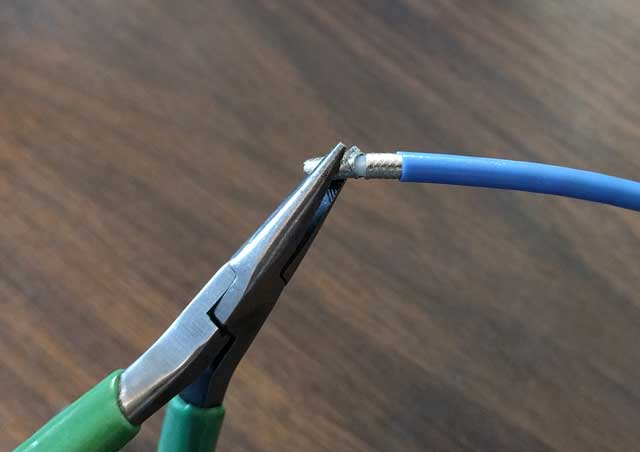 Using
a pliers, bend the shield end back and forth, breaking it away at the scored
location. Once it is broken, it can be removed with a pair of diagonal cutters,
or just pulled away from the end of the cable. This needs to be done at both
ends of the balun.
Using
a pliers, bend the shield end back and forth, breaking it away at the scored
location. Once it is broken, it can be removed with a pair of diagonal cutters,
or just pulled away from the end of the cable. This needs to be done at both
ends of the balun.
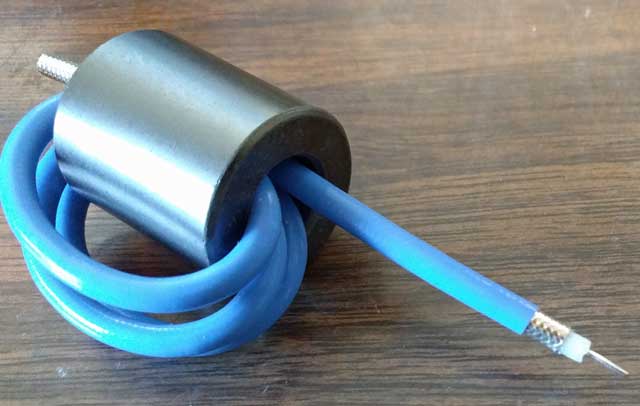 On
both ends, remove all but 2 or 3mm of insulation from around the center
conductor, taking care not to cut into the center conductor itself. The balun is
now ready to be installed.
On
both ends, remove all but 2 or 3mm of insulation from around the center
conductor, taking care not to cut into the center conductor itself. The balun is
now ready to be installed.
 Disregard
the single bifilar-wound drain choke in this and all the remaining photos
(it is not the type being used now).
Disregard
the single bifilar-wound drain choke in this and all the remaining photos
(it is not the type being used now).
Beginning with the longer lead, form the center conductor so it will lie flat on the trace in plane with the outer, and solder it in place across the gap as shown; center conductor soldered to the left side, outer soldered to the right.
 In
this step, you'll need to bend the coax down and then level again as it
exits the core, and secure the ends as shown. Solder the outer conductor first,
then bend the center conductor down onto its trace and solder it in place.
In
this step, you'll need to bend the coax down and then level again as it
exits the core, and secure the ends as shown. Solder the outer conductor first,
then bend the center conductor down onto its trace and solder it in place.
 Just one last thing before the output board is finished; the kit contains a
30pf coaxial capacitor made from TC-18 Teflon coax. If you find (during testing)
the output of the RF deck to be a bit low on the higher bands (6m in
particular), use the capacitor. The center conductor is soldered to the output
trace and the shield to ground; the other end is open and should be secured
(with the supplied cable ties) so it does not contact other components or short
to ground.
Just one last thing before the output board is finished; the kit contains a
30pf coaxial capacitor made from TC-18 Teflon coax. If you find (during testing)
the output of the RF deck to be a bit low on the higher bands (6m in
particular), use the capacitor. The center conductor is soldered to the output
trace and the shield to ground; the other end is open and should be secured
(with the supplied cable ties) so it does not contact other components or short
to ground.
The capacitor is made from Teflon coax to enable it to withstand very high
voltages; when the rf deck is used with a reflective LPF, harmonic energy
returned to this location on some bands created voltages high enough to destroy
even 3kv capacitors.
Continuing now with assembling the input board; install all components (except T1) as shown in their locations below. The component locations for C5, rtb1, C6 and rtb2 are not used in this design. The 51 ohm 1w resistor (not shown here) is installed across the R11 and R12 gate pads.

 Cut
8 inches of RG316 and remove 5mm of insulation from the center,
exposing the shield in that location. Tin the shield there.
Cut
8 inches of RG316 and remove 5mm of insulation from the center,
exposing the shield in that location. Tin the shield there.
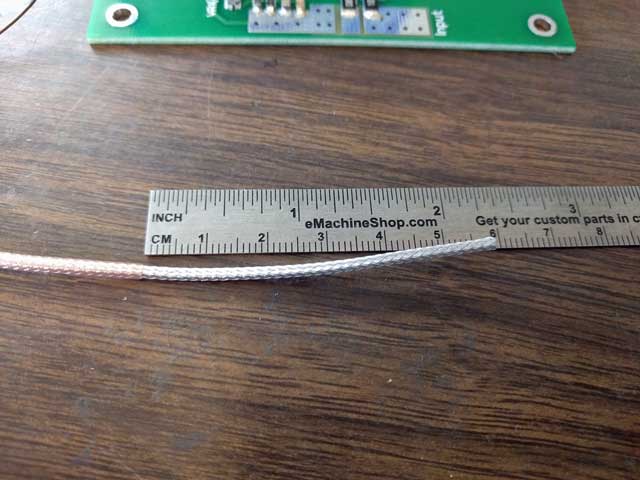 Remove
2.25 inches insulation from each end, exposing the shield.
Remove
2.25 inches insulation from each end, exposing the shield.
 Holding
the shield in place with your left hand, push the right end of the shield to the
left, forming a mushroom bulge about 5mm away from the insulation on the left.
Tin the 5mm of shield at the spot referenced by the red arrow.
Holding
the shield in place with your left hand, push the right end of the shield to the
left, forming a mushroom bulge about 5mm away from the insulation on the left.
Tin the 5mm of shield at the spot referenced by the red arrow.
 Using
a pair of diagonal cutters with the cutting blades parallel to the coax, trim
away the mushroom bulge and slide the loose shield off of and away from the
insulated center conductor.
Using
a pair of diagonal cutters with the cutting blades parallel to the coax, trim
away the mushroom bulge and slide the loose shield off of and away from the
insulated center conductor.
 Install
the coax into the smaller ferrite core in criss-cross fashion as shown.
Install
the coax into the smaller ferrite core in criss-cross fashion as shown.
 Position
the transformer as shown, and pass the coax on the left across the core to the
right, then through the core from right to left. Solder the exposed shield
to the left gate trace, taking care not to bridge the gap between the traces.
Position
the transformer as shown, and pass the coax on the left across the core to the
right, then through the core from right to left. Solder the exposed shield
to the left gate trace, taking care not to bridge the gap between the traces.
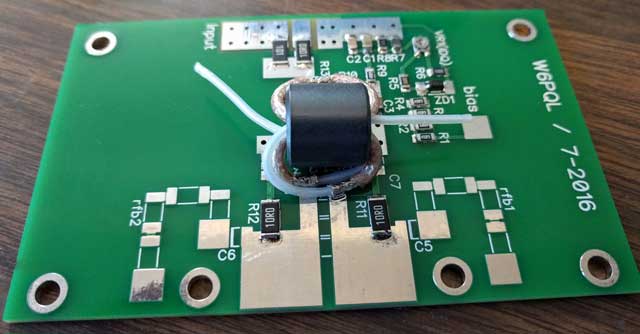 Pass
the coax on the right across the core to the left, then through the core from
left to right. Solder the exposed shield to the trace on the right, taking care
not to bridge the gap between the traces.
Pass
the coax on the right across the core to the left, then through the core from
left to right. Solder the exposed shield to the trace on the right, taking care
not to bridge the gap between the traces.
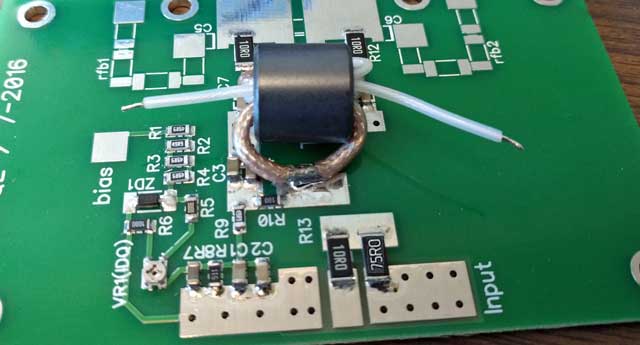 Taking
care not to cut into the center conductor, trim 4mm of insulation away from the
ends and tin them. Solder the coax center tap to the trace below it (one end of
R10 is also connected to this trace).
Taking
care not to cut into the center conductor, trim 4mm of insulation away from the
ends and tin them. Solder the coax center tap to the trace below it (one end of
R10 is also connected to this trace).
 Solder
the upper wire to the trace with R13, and the lower end to the ground trace next
to C3. The input board is finished.
Solder
the upper wire to the trace with R13, and the lower end to the ground trace next
to C3. The input board is finished.
 Your
heat sink should be drilled/tapped for 40-40 machine screws (or your metric
equivalent) using the
pattern in this template.
Your
heat sink should be drilled/tapped for 40-40 machine screws (or your metric
equivalent) using the
pattern in this template.
Position your copper spreader (with LDMOS attached) over the drilled pattern in your heat sink.
The recommended way to attach your LDMOS to the copper spreader is to flow-solder it as you see it pictured here. Machined spreaders with LDMOS attached using this process are available on the parts page here.
You can use screws to mount your LDMOS, but the heat transfer and rf
grounding will be inferior.

Slide the boards into place under the transistor tabs

Secure the board and spreader to the heat sink with 4-40 x 5/8 machine screws (or your metric equivalent) using flat washers under the screw heads. Once the boards are in proper position, tighten the screws.
Solder the 4 transistor tabs to the PC boards.
Turn on the 50v main supply voltage, but not the bias; there should be no current drawn
Turn on the bias and note the idling current drawn from the 50v supply. Adjust IDQ for 2 amps. Note: the current drawn by the bias supply (usually12v) is not what you are measuring here...you must measure the idling current (IDQ) the LDMOS draws from the 50v supply.
Shut off the power supply, and remove current limiting.